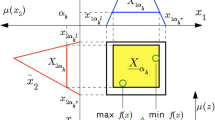Abstract
The principle of solving multiobjective optimization problems with fuzzy sets theory is studied. Membership function is the key to introduce the fuzzy sets theory to multiobjective optimization. However, it is difficult to determine membership functions in engineering applications. On the basis of rapid quadratic optimization in the learning of weights, simplification in hardware as well as in computational procedures of functional-link net, discrete membership functions are used as sample training data. When the network converges, the continuous membership functions implemented with the network. Membership functions based on functional-link net have been used in multiobjective optimization. An example is given to illustrate the method.



Similar content being viewed by others
Explore related subjects
Discover the latest articles, news and stories from top researchers in related subjects.References
Bellman RE, Zadeh LA (1970) Decision making in a fuzzy environment. Manage Sci 17:141–162
Zimmermann H-J (1976) Description and optimization of fuzzy systems. Int J General Syst 2:209–215
Zimmermann H-J (1983) Fuzzy mathematical programming. Comput Oper Res 10:291–298
Luhandjula M K (1989) Fuzzy optimization: an appraisal. Fuzzy Sets Syst 30:257–282
Rao SS (1987) Multiobjective optimization of fuzzy structural systems. Int J Numer Meth Eng 24:1157–1171
Dhingra AK, Rao SS (1995) Cooperative fuzzy game theoretic approach to multiple objective design optimization. Eur J Oper Res 83(3):547–567
Rao SS, Chen L (1996) Generalized hybrid method for fuzzy multiobjective optimization of engineering systems. AlAA J 34:1709–1717
Huang HZ (1997) Fuzzy multi-objective optimization decision-making of reliability of series system. Microelectron Reliab 37(3):447–449
Huang HZ, Wu WD, Liu CS (2005) A coordination method for fuzzy multi-objective optimization of system reliability. J Intelligent Fuzzy Syst 16(2):1–8
Jimenez F, Cadenas JM, Verdegay JL, Sonchez G (2003) Solving fuzzy optimization problems by evolutionary algorithms. Inf Sci 152:303–311
Pedrycz W (1994) Fuzzy neural networks: concepts, models, optimization. In: Deluged M, Kacprzyk J, Verdegay J-L, Vila MA (eds) Fuzzy optimization: recent advances. Physica-Verlag, Heidelberg
Sakawa M, Sawada K (1994) Fuzzy multiobjective 0–1 programming through neural computations. In: Deluged M, Kacprzy k J, Verdegay J-L, Vila MA (eds) Fuzzy optimization: recent advances. Physica-Verlag, Heidelberg
Park GH, Pao YH (1998) Training neural-net controllers with the help of trajectories generated with fuzzy rules (demonstrated with the truck backup task). Neurocomputing 18(1–3):91–105
Pao YH (1988) Adaptive pattern recognition and neural networks. Addison-Wesley, Reading, MA
Pao YH, Takefuji Y (1992) Functional-link net computing:theory, system architecture, and functionalities. Computer 25(5):76–79
Huang HZ (1997) Fuzzy optimization design of mechanical system: principles and applications. Science Press, Beijing
Klassen M, Pao YH, Chen V (1988) Characteristics of the functional link net: a higher order delta rule net. IEEE International Conference on Neural Networks, San Diego, CA, USA
Huang HZ (1995) Reliability analysis method in the presence of fuzziness attached to operating time. Microelectron Reliab 35(12):1483–1487
Simoes LMC (2001) Fuzzy optimization of structures by the two-phase method. Comput Struct 79(26–28):2481–2490
Acknowledgements
This research was partially supported by the National Natural Science Foundation of China under the contract number 50175010, the National Excellent Doctoral Dissertation Special Foundation of China under the contract number 200232, and the Natural Sciences and Engineering Research Council of Canada. Constructive suggestions and comments from the referees and editors are very much appreciated.
Author information
Authors and Affiliations
Corresponding author
Rights and permissions
About this article
Cite this article
Huang, HZ., Wang, P., Zuo, M.J. et al. A fuzzy set based solution method for multiobjective optimal design problem of mechanical and structural systems using functional-link net. Neural Comput & Applic 15, 239–244 (2006). https://doi.org/10.1007/s00521-006-0025-2
Received:
Accepted:
Published:
Issue Date:
DOI: https://doi.org/10.1007/s00521-006-0025-2



